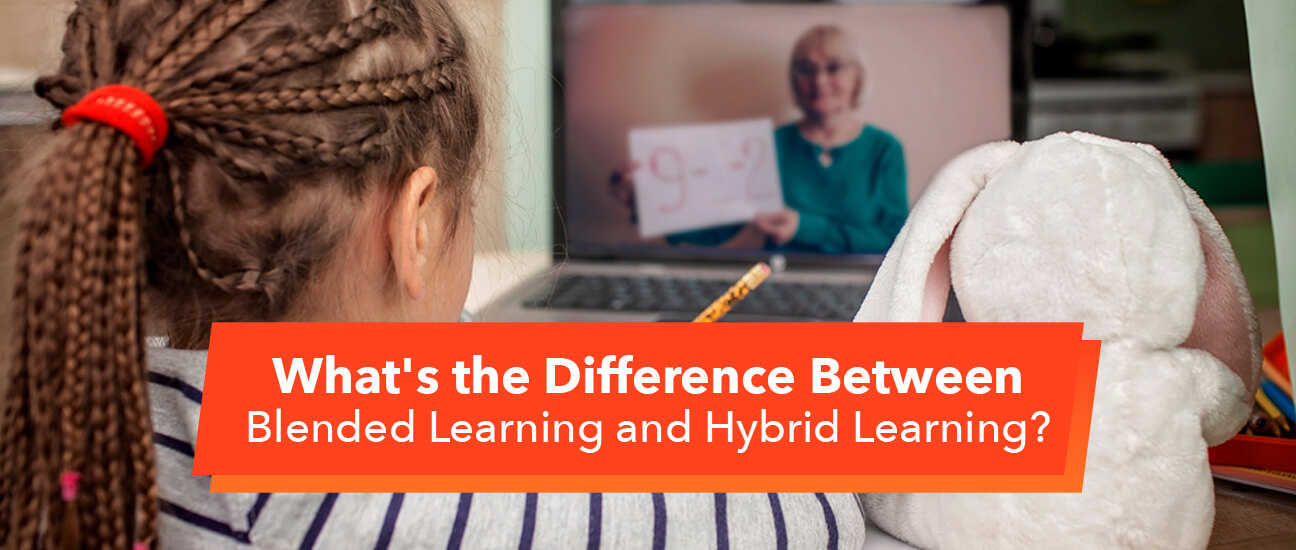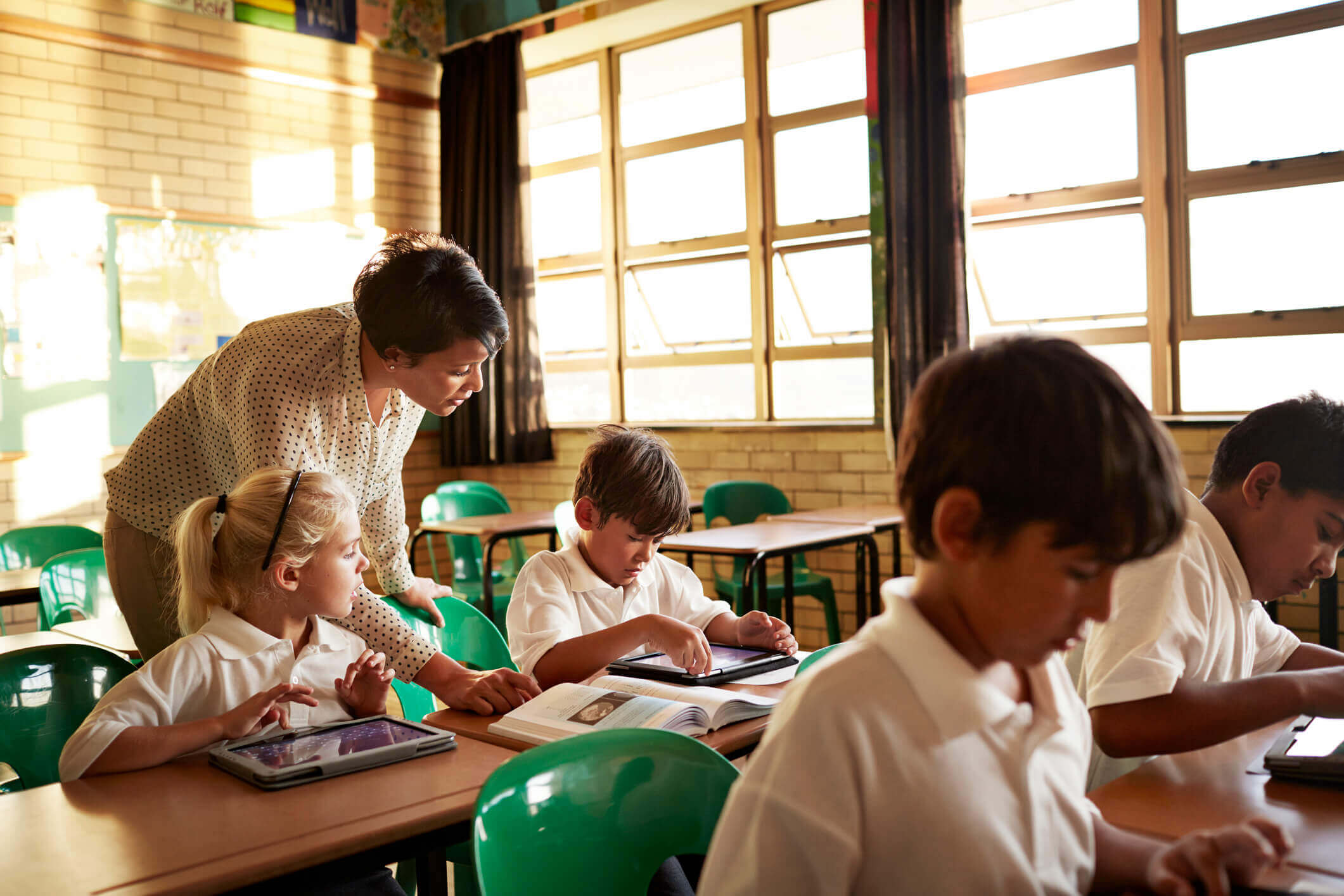Published on November 8th, 2021
What’s the difference between hybrid and blended learning?
11 minute read

Hybrid and blended learning are two concepts which have grown rapidly recently. Educators around the world were incorporating more and more of these approaches into their classroom in recent years, before the COVID-19 crisis dramatically accelerated the process.
But what’s the difference between the two approaches? And just how do your students benefit?
In this article, we’ll help you understand the key differentiator between hybrid and blended learning, how both benefit your students and how you can implement them into your classroom.
The difference between hybrid and blended learning
On the face of it, blended and hybrid approaches are the same: students learn using a combination of in-person and online elements. People often use the terms interchangeably because of this.
Despite their obvious similarities, however, the two approaches do differ in a handful of aspects. The major differentiator between the two is their overall approach to online learning.
In a hybrid learning environment, the online component replaces an element of the in-person lessons and is designed to provide students with the flexibility to complete different elements of the in-person syllabus on their own time. A blended approach, however, uses the online approach to complement and enrich the in-person class, with both aspects working in sync to create a richer student experience.
What is hybrid learning?
Hybrid learning is an educational model which enables students to attend class in-person or from home. This could either be through in-person and remote learners attending the same class on a specific schedule or syllabus materials being uploaded to a portal for learners to work through on their own time.
Properly implemented, a well-run hybrid learning approach enables all students to engage with the course material on their own time. This provides incredible flexibility for all students and is an approach which has traditionally been used in higher education, where students are able to use the hybrid learning model to balance their studies with work, childcare and other responsibilities.
What is blended learning?
Blended learning combines or ‘blends’ online and face-to-face learning. When utilising this approach, educators supplement the in-person classes with online activities designed to enhance their learning.
Unlike hybrid, blended learning requires in-person classroom time between teachers and students. A typical model could see a course using the following approach:
- Students come into the classroom and are provided with top-level information on the topic in question
- After class, learners go home and use the online course materials to develop a much deeper understanding of the material
- Teachers can then use the next lesson as a discussion session which gives students the opportunity to apply the additional knowledge they’ve gained discussing the topic with each other and gain additional insights from both their peers and teachers.
Focusing on this approach helps students gain a much deeper understanding of the course material than before to enhance their overall outcomes.
How implementing a blended or hybrid learning approach benefits your students
Hybrid learning is most commonly used in higher education settings to provide learners with additional flexibility – this flexibility is commonly cited as the major reason to switch to a hybrid approach.
Students get to engage with the course materials at a time suited to their schedule, rather than worrying about missing lessons because of important appointments and teachers have the flexibility of delivering their material in a way which suits the students.
Alongside this, the hybrid approach of having in-person and remote learners in the same class means distance students are just as able to engage in synchronous conversations about the topic at hand with their classmates as in-person learners, something that can significantly enhance their learning experience.
Research has shown that blended learning helps achieve high levels of student attainment more effectively than face-to-face learning.
When you use a blended approach in your classroom, you combine digital and classroom instruction into a cohesive whole designed to enhance students’ understanding of the subject at hand. Students build on the foundations given in the classroom in their online learning environment before coming together to further enhance their understanding through peer discussion and the ability to ask more insightful questions.
While students are working on their own to understand new concepts, teachers are also freed up to spend more one-on-one time with students taking longer to gain a full understanding of the subject matter. This both enhances grades of struggling students and allows those who do find the subject easier to move forward and stay engaged, rather than waiting for others to catch up.
Top tips for successfully implementing blended or hybrid learning into your classroom
Successful implementation of hybrid and blended learning approaches requires careful thought. Every situation is unique, so you’ll first need to establish how you think a change in learning approach will benefit your students and if this outweighs any costs associated (be they financial or educational). If you do decide to make a move to one of these approaches, however, these tips will help you make it a successful change:
Use in-person class time for group activities
Group discussions and similar activities which provide learners with the opportunity to discuss the topic in detail are key drivers of understanding. Carefully planning your syllabus to make the most of these opportunities while allowing people to work on the basics on their own will provide a huge boost to your students.
For example, if you’re planning a lecture, you could pre-record this and put it online for students to watch. Students would then come to your classroom with an understanding of the topic built-in and can use the time they would have spent taking notes, having conversations and digging deeper into the subject matter.
Make the most of the tools available to you
Educational software such as Promethean’s cloud-based teaching software, ClassFlow, provides teachers with a number of tools to enhance student learning, and the time switching to a blended or hybrid model is the perfect time to examine these tools to discover how you could further enhance learning.
If lectures are required, for example, these can easily be saved to a shared drive to be accessed at any time. Or maybe you think students would benefit from a more practical approach? The use of classroom games during your face-to-face instruction could provide a real boost to engagement and understanding.
Remember learning is a two-way street
A particular risk of a hybrid learning approach is that distance learners can fall into a very one-sided education rhythm in which they simply receive the material, study it on their own and submit assignments. This leads to disengaged students and missed learning opportunities.
Build in specific time to engage with students and facilitate conversations – whether through simple online polls or regular online Q&A sessions which allow everyone to get together and discuss the most recent material.
Collect student feedback
With flexibility being one of the foremost benefits of these learning styles, it makes sense to use that to its full potential. Adjusting how you work is the ideal time to maximise this opportunity by collecting feedback from your students on how they like to learn, so you can have truly pupil-centred learning.
While there are standard ways of operating when using a blended or hybrid approach, every class is unique and has its own requirements. Take the time to establish what balance your class prefers, how they think in-class time will benefit them the most and any opportunities they feel are being missed currently to really drive improvement in your classroom outcomes. A little communication can make a huge difference.
Hybrid & blending learning with Promethean
The Promethean ActivPanel interactive display provides the most intuitive and integrated learning experience available. Packed with enhanced interactivity, productivity, and engagement tools, the ActivPanel helps teachers and students make the most out of every moment– inside or outside the classroom.
Promethean’s screen share application allows for multi-device mirroring (available on all panels) which enables teachers to move freely and teach from anywhere in the classroom. During a lesson, the teacher can interact with shared screens (whether in-call or at home) directly from the ActivPanel, increasing student collaboration and participation.
To learn more about how Promethean can help you succeed with hybrid and blending learning, request a free live demo with one of our experts today!




